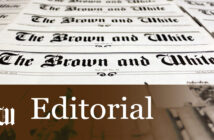In the early morning of Nov. 6, 2013, residents of the Umoja House woke to their home vandalized with spray-painted racial slurs and smashed eggs. After a complaint was filed with the Office for Civil Rights about the university’s handling of incidents of hate on campus, the office determined Lehigh needed to officially understand its climate in order to address it.
This fall, the university released The Lehigh Survey, which aimed to understand the experiences of Lehigh community members as it relates to race, ethnicity, national origin, gender and sexuality. The survey is one mandate in Lehigh’s Voluntary Resolution Agreement with the OCR to ensure the campus is compliant and inclusive.
From Oct. 10 through Nov. 10, students, faculty and staff were encouraged to participate in the survey — the first opportunity since 2006 for the collective community to voice its opinion on the state of Lehigh’s culture and climate. It garnered responses from 41.8 percent of the campus, with 65 percent of staff, 53 percent of faculty and 36.5 percent of students participating.
The last time the Lehigh administration asked its entire community to weigh in on the campus climate was in Alice P. Gast’s first year as university president. In 2006-07, the university distributed a campus-wide survey to identify and address climate issues.
The results of the 2007 survey – which was created, distributed and analyzed by Rankin and Associates Consulting – revealed “a stark reality of the disgraceful experiences of our friends and colleagues that cannot be tolerated,” according to an open letter from then-president Gast. Overarching issues – offensive conduct based on race, gender and hierarchy – emerged in the survey’s responses.
Mandating The Lehigh Survey
According to Karen Salvemini, Lehigh’s equal opportunity compliance coordinator, the OCR required The Lehigh Survey to explore issues of race, ethnicity and national origin. The university independently chose to add questions studying gender and sexuality.
After learning about the survey, faculty from the psychology and education departments asked if they could develop it. The initiative was led by department chair Gordon Moskowitz, Christopher Burke, Christopher Liang and Dominic Packer, in addition to Jennifer Jensen, the deputy provost for Academic Affairs; Yenny Anderson, interim vice provost for the Office of Institutional Research; and Meg Munley, a research analyst.
“There are several of us in the psychology department who do research on stereotyping, prejudice and attitude change, and we have felt for many years that the university ought to be doing these types of surveys,” Moskowitz said.
While the university has not distributed a campus-wide survey since 2007, Jensen said it has asked climate-related questions in surveys — like the senior exit survey, the student health survey and other faculty and staff surveys — to get an understanding of the community’s perspective.
“When you look at something and you see trends about universities, it’s not unreasonable to assume that we are dealing with some of the same issues,” Jensen said. “Just because we’re not surveying you every year doesn’t mean we’re not paying attention to what the trends and issues would be on our campus.”
Salvemini said a big concern for researchers is survey fatigue. This influenced the length of The Lehigh Survey, but she said it’s also why the university was previously hesitant to release annual campus-wide climate surveys.
“My personal hope is that they do not require us to keep surveying every group every year, because we’re worried about survey fatigue,” Jensen said. “I believe the changes we see from one year to the next will be small, and I would rather have good response rates from all students say their freshmen and senior years.”
The OCR agreement requires Lehigh to conduct the survey for at least the next three years.
The majority of the survey is consistent in the questions it asks asks to students, faculty and staff. Some questions – such as those exploring hierarchy in faculty and staff – are tailored toward specific issues in those groups.
Moskowitz said his team didn’t just want to understand demographic and factual issues. The survey also included measures to assess the motivations and attitudes of Lehigh’s community members.
Unlike the Rankin survey, though, The Lehigh Survey did not specifically target responses from minority groups on campus.
“I want all sorts of answers,” Jensen said. “You’re a graduate student, I want you answering this survey. You’re a white fraternity member, I want you answering this survey.”
But Moskowitz emphasized the value in getting responses from constituencies beyond students.
“(It’s important to) look at staff and faculty, because (they) live here for decades,” Moskowitz said. “I know we are an institution serving students, but the people that work here serving those students are here for much of their lives…. We want to understand what’s driving each of those communities. They may be very different.”
Identifying challenges in 2007
During the summer of 2006, a diversity and leadership committee contacted Rankin and Associates “to assist in identifying successes and challenges with respect to underrepresented groups by developing and conducting an internal assessment,” according to the survey’s final report.
Though offered to the entire community, the survey specifically targeted responses from minority groups on campus. According to the final report, the survey aimed to gather personal anecdotes, experiences and facts about Lehigh’s climate in terms of academia, the institution and administrative actions.
It gathered responses from 64.1 percent, 88.6 percent and 59.3 percent from black, Asian and Latino participants, respectively. Though white participants responded at a rate of 41.6 percent, that group still made up 79 percent of the total survey responses.
Results of the survey indicated Lehigh was experiencing “several challenges in regard to diversity issues.” However, they were challenges consistent with trends in higher education across the nation, according to the final report.
Eleven percent of respondents said they had personally experienced offensive, hostile or intimidating conduct that interfered with their ability to exist on campus. Of this percentage, people of color and members of the LGBT community experienced discrimination issues at a higher rate than white and heterosexual people, and believed it was because of their race and sexuality.
“I just think a lot of people here are blind to the way they treat, look at and act (toward) other who are different than them,” says one anonymized survey response regarding race and ethnicity harassment. “Being the only black female in a class is pure hell because I’m either looked at as a charity case, not smart enough to be in the class or the ‘token black girl’ who can answer all the ‘black questions.’”
Results indicated more employees experienced harassment than students, prompting the university to take action on behalf of the community members who stay at Lehigh beyond four years of education.
“We are actively seeking sustainable approaches to making Lehigh University a productive and collegial place where we can be ourselves,” Gast wrote.
According to a Brown and White article from March 2007, Lehigh’s administration immediately acted on the findings of the survey. That year the university hired Timothy Gardner, its first LGBTQA program director, expanded the multicultural affairs office with the promotion of John McKnight to assistant director and created the Council for Equity and Community.
But according to Moskowitz, in 2007 people were displeased the results had not been more widely communicated and the administration had not acted enough on them.
“A whole bunch of organizations around campus formed,” he said. “Faculty and staff (had) been very active in taking initiatives, but there was not a climate survey to accompany it. People were at the grassroots level forming organizations to address needs they felt existed, but the idea of there being a consistent sort of taking the temperature of the university on these types of issues wasn’t something that seemed to be gaining steam at the administrative level.”
After Lehigh signed the Voluntary Resolution Agreement, then-president Kevin Clayton sent a letter to the community in early 2015 summarizing actions the university would take to ensure the campus was welcoming and non-discriminatory. He noted in this letter that some of the “very candid comments offered by (2007) survey respondents have informed our understanding of the key issues involved, as well as the policy decisions we are making to address them.”
Results
The Office of Institutional Research is responsible for aggregating the results of the survey and sending a report to the OCR within 45 days of its completion. Anderson said the office will also send an anonymized subset of data to the psychology faculty to do their own analysis.
Salvemini said the university has yet to determine how it will present the results of the survey to the campus community, but the intention is to make the results public some time in the spring semester. Subsequent actions on behalf of the administration depend on what the community decided to share in the survey.
The Council for Equity and Community is tasked with making some of these suggestions. Faculty who worked on the study will also publish their own academic research independent of Lehigh, Moskowitz said.
“The university is dedicated to getting this right and they are going to allow us to analyze the data so that if anyone felt as if the institution had something to hide, we don’t,” Moskowitz said. “I don’t work for anybody, so what I choose to do with the data will be my own decision. I hope there won’t be any sort of sense that there would be incomplete reporting, and I hope that people will trust that the institution will report it accurately. I do.”





Comment policy
Comments posted to The Brown and White website are reviewed by a moderator before being approved. Incendiary speech or harassing language, including comments targeted at individuals, may be deemed unacceptable and not published. Spam and other soliciting will also be declined.
The Brown and White also reserves the right to not publish entirely anonymous comments.